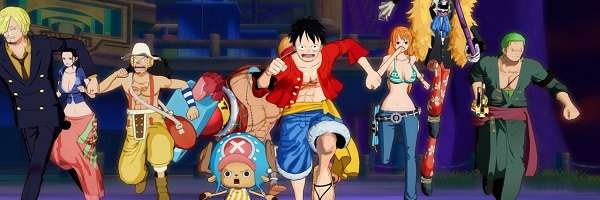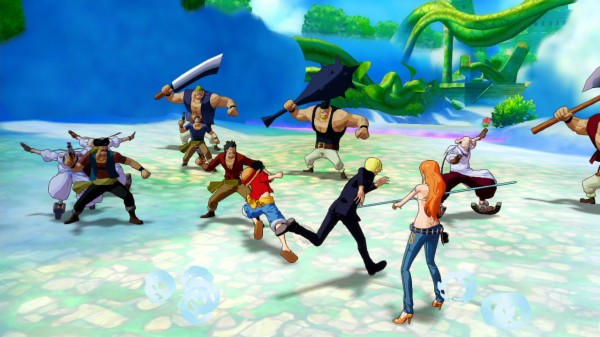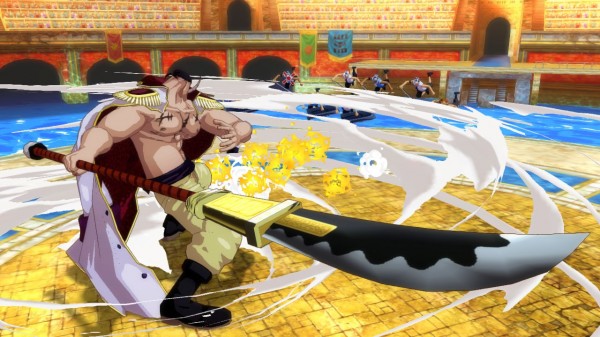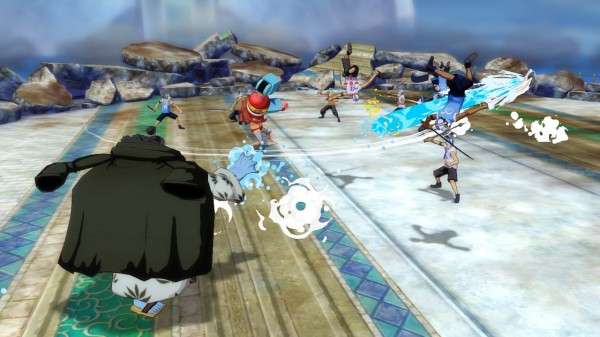
One Piece: Unlimited World Red Wii U / Vita Review
It’s kind of crazy to think that an anime as popular as One Piece was only licensed last year by Manga to sell the series on DVD in the UK. We had the awful 4Kids dub a few years ago that ripped everything left, right and centre out of the show, but was finally given to FUNimation to offer fans a more close to nature (although it still got some slight edits) experience of the original Japanese anime. This is a show that began airing 15 years ago, and is still one of the most popular animations in Japan today.
With a mass of fans all over the world, it only makes sense that more One Piece games are making it across the ocean to English speaking lands. One Piece: Unlimited World Red is the latest title in the franchise from Bandai Namco, but does it fall into the trap of repeating the same scenarios that often plague anime games time and time again? And can it match the quality of Bandai Namco’s currently best anime series, Naruto Shippuden: Ultimate Ninja Storm?

The story for Unlimited World Red allows for the mixture of fan favourite heroes and enemies to clash with each other again, although, done through an original story that begins with the heroes arriving on an island after a long journey out at sea. All seems normal, until night time arrives and all of Luffy’s friends are kidnapped during the cover of the dark. It’s not long until your friends are back and the enemy reveals themselves to you in a way that allows for the game to throw in a collection of places and villains that will be familiar to fans. This is a story that, while new, will still appeal more to people who know the source material rather than newcomers, as it simply preys on the knowledge that people have for the characters in the world of One Piece and their relationship with each other. That’s not to say newcomers will be lost with the story, as what’s here is a simple plot conjured to make this game a collection of famous locations and fights that have happened over the history of the show/manga. You’re better off watching the show or reading the manga to truly experience the great One Piece story arcs.
Unlimited World Red is an action game with a blend of adventure. There’s certainly a lot of fighting, and from quick videos it might seem to look like it’s influenced by the Dynasty Warriors formula, but Unlimited World Red constructs itself with a slower paced battle system and one that doesn’t quite match up with the hundreds of soldiers that the Dynasty Warriors games are known for. In fact, combat is rather on the shallow side, with each character having all their combos unlocked at the start, and with the simple chaining of two buttons to distinguish different attacks, there aren’t many combo alterations to play with. You can jump to do air attacks, or use the dash button that is also in place as a context sensitive block/dodge/counter when the button prompt is on screen during a fight, but these don’t stop the issue of the fighting becoming stale or helping against its stiffness. The only progression for the combat system is when the character in use gains a new special attack, which uses a chuck of an energy bar that sits under your health metre to perform a high damaging attack or a short cinematic special move. The problem with the combat is that it leaves players with a 12 hour gaming experience (main story finished along with some side quests) that feels similar from beginning to end.

A couple of things are included to help levitate the shallow combat, which it does for a while at least. The first is that the game will put up a list of combos that you should perform in the fight. If you manage to do this correctly, then you’ll get a break bonus that offers a buff to the character for a short time. Another good change of pace is the chance to play one of the nine available characters in the story mode and use their unique attack styles. Luffy – the iconic protagonist of the series – uses his trademark rubber limbs to attack and pound enemies with rapid punches or kick people in the face with his Dhalsim inspired stretchy legs. Zoro uses his three swords to offer offensive-based combat, with the extra blade situated in his mouth for that extra bit of bizarre flavour. Zoro has a fantastic special move that can be abused so much. This move is a buff that makes his attacks stronger, and I found activating this and locking on enemies or a boss made mincemeat of their life metre, as Zoro seems to manage to dodge through the bosses when he’s in this double speed/attack buff mode. After experimenting with the characters, you’ll no doubt find your favourite three and stick with them, and while you might become exhausted of the combat towards the latter half of the game, at least during battle you can switch between the three with a click of a button, making the combat just about bearable until you’re done with the content on offer.
Level design is something that could have done with more variety. The locations are fine – very colourful and are based from places in the show, but they feel empty, with enemies hardly filling up the space of the land. There’s a lot of time where you’re exploring and nothing is happening. The levels are flat, with the occasional requirement to climb up stairs or jump over a gap. There’s also not much to do in them, with a fishing spot or random side quest, such as catching animals that scatter around the level, adding nothing but shallow activities. You can usually tell where a fight will happen, since these are often situated in open areas, setting up an arena based fight where an invisible barrier will you keep you within circular confines of the battle.

Battles aren’t always like this, sometimes they will just be enemies that won’t lock you from running away, but either way, the levels should be used for more than just flat decorations. It also doesn’t help that the camera can be bothersome, cutting off the view of the action when it decides to get too close to the character or get stuck behind a piece of scenery. It would do this to me at least a few times within each story chapter, which is usually around 20 to 30 minutes long. In this day and age, no person should have to battle with the camera, even more so in a game that includes a lot of action.
When not taking part in the story, the home base of Trans Town will act as a hub in which townsfolk will offer side quests in exchange for items and experience points. The village has its own mini-game that involves upgrading the town with new buildings, such as a pharmacy, so you can buy healing items. Each building has a benefit for the player. There’s a decent amount of content to do that is away from the story mode, and if people like accomplishing fetch quests that requires punching objects in a story mission and picking up the random drop of loot, or hunting down the required number of items, fish (from the fishing mini-game) or animals, then you’ll have plenty to do here – it’s just not all that exciting and can be very repetitive revisiting the same lifeless stages.

Coliseum is where you can go for some separate battle fun. Additional characters are included in this mode that aren’t limited to Luffy’s pirate buddies, so this means that characters like Buggy, Whitebeard and Akainu can all be used in Coliseum mode. This section has its own narrative, as it sets you up to fight through various battles, but without all the RPG experience level system of the story mode. It’s a good inclusion for additional content, and while it’s only arena based combat (being either 1v1 or 2v2) it makes for a change of pace after finishing exploring around the levels of the story mode. An option to bring in a friend for two-player cooperative play is here, but it’s only local only.
The power of consoles is seemingly at the point where any anime game can look fantastic and represent its source material extremely well. This is the case with Unlimited World Red, where the artistic design and colour truly shines on the Wii U. It’s not what I would call a great looking game in the sense of what it’s doing with graphical effects, and evidence that this isn’t a game built ground up for the Wii U is clearly here (for example, low quality textures coming in from the other versions of the game), but for representing the source material, it’s a very colourful game that feels like you are in the world of the anime. The audio is Japanese only, an option that I assume Bandai Namco took to cut the cost on bringing the game here. Everything is fully subtitled, so you’re not missing much, and the action is simple enough that you can read what’s going on while hammering away on the buttons.

One Piece: Unlimited World Red isn’t the best One Piece game, nor is it as good of an experience as last year’s One Piece: Pirate Warriors 2. However, I do feel that fans of the show will get a kick out of the game if they have the tolerance to forgive the standard combat mechanics and unexciting level design. So much more can be done with this formula, and it’s a shame that something as big as One Piece hasn’t been given a game that reaches the greatness of Naruto. Hopefully that time will come, but for the latest One Piece video game, there is enough here to feel like you’ve had your worthwhile, you’ll just wish that the final product was more masterfully crafted than what’s on offer here.
